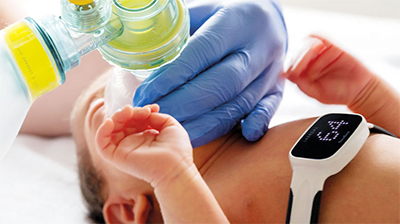Evaluating the safety and efficacy of tools and therapies in the neonatal environment is essential for improving processes and standards of care. Neonatologists at NewYork-Presbyterian Komansky Children’s Hospital and Weill Cornell Medicine are committed to advancing the application of innovative tools and therapies to optimize outcomes for their youngest patients.
Detecting heart rate quickly and efficiently is critical to guiding delivery room neonatal resuscitation. Faculty in the Division of Newborn Medicine at Weill Cornell Medicine undertook a study to evaluate the NeoBeat Newborn Heart Rate Meter, a dry electrode ECG device, to determine whether it could more rapidly detect heart rate than pulse oximetry or portable ECG. In their research, published in the Archives of Disease in Childhood: Fetal and Neonatal Edition, the neonatology team observed delivery room resuscitations of 28 pre-term and full-term newborns who were relatively well and required minimal intervention.
Taking only seconds to put on a newborn’s abdomen, NeoBeat displays the heart rate instantaneously and can help guide neonatal resuscitation.
The researchers confirmed that NeoBeat could be placed more quickly and consistently acquired heart rate faster than either pulse oximetry or ECG used in the pilot study cohort. It also provided an accurate and continuous display of newborn heart rate. Taking only seconds to put on a newborn’s abdomen, NeoBeat displays the heart rate instantaneously and can help guide neonatal resuscitation.

“An important advantage of NeoBeat is its ease of application, not requiring skin preparation or adjustment of cables and leads,” the authors wrote. “This mitigates user variability in device application and ensures consistently rapid heart rate detection. The ability to place the NeoBeat on the upper abdomen also offers the important advantage of continued access to the newborn chest during resuscitation.”
In particular, the placement of NeoBeat minimizes interference with critical maneuvers such as:
- heart and lung auscultation
- assessment of chest rise during ventilation
- optimal performance of chest compressions
These features, note the authors, “make NeoBeat a unique and potentially superior modality for use in more complicated delivery room resuscitations.”




